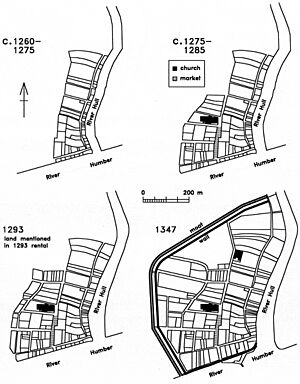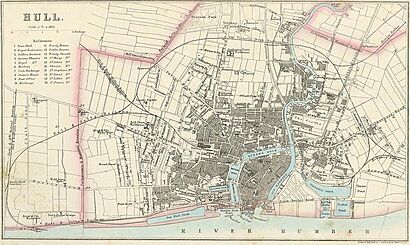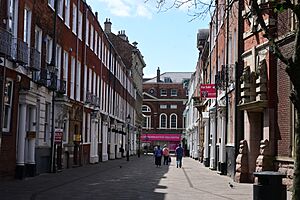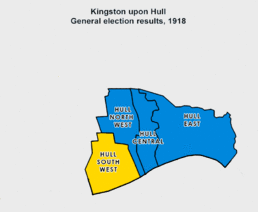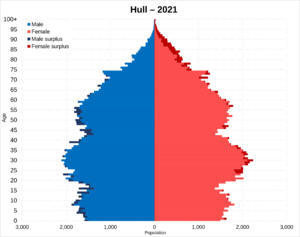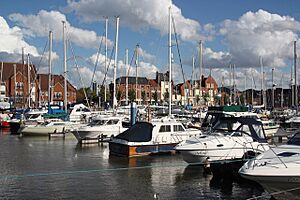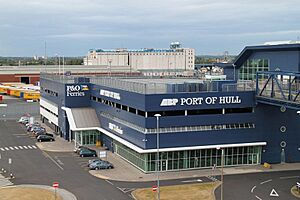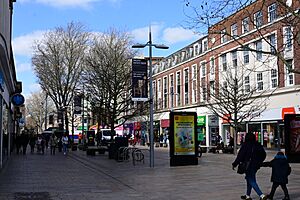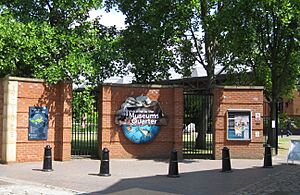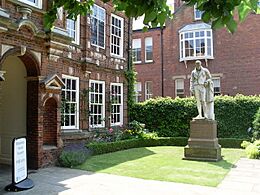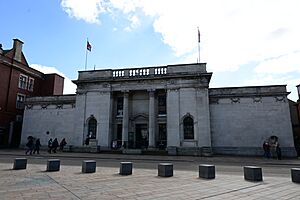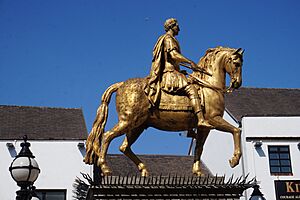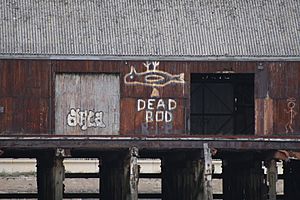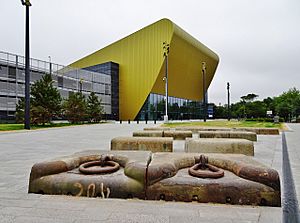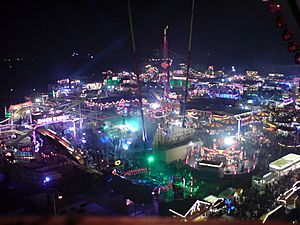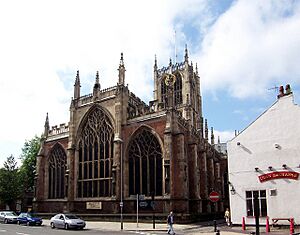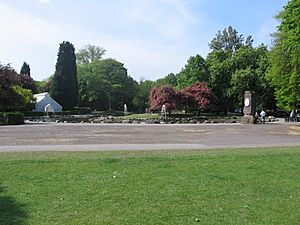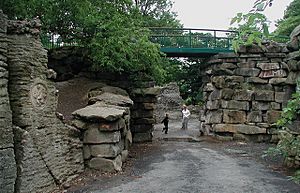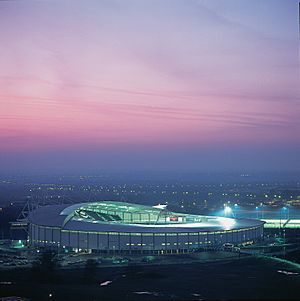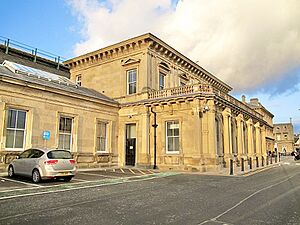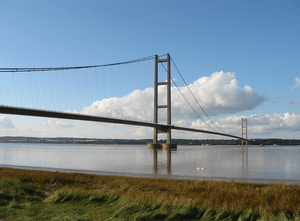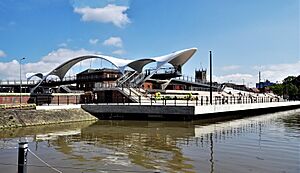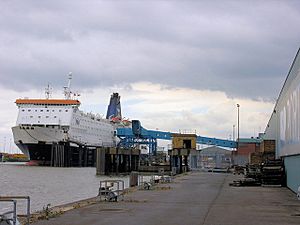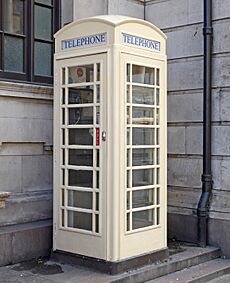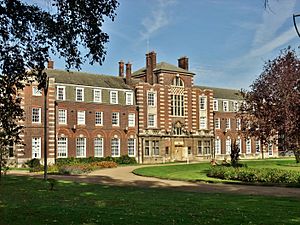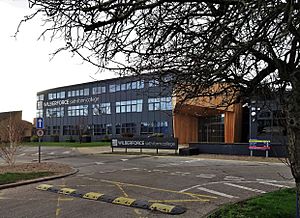Kingston upon Hull facts for kids
Quick facts for kids
Kingston upon Hull
Hull
|
||
|---|---|---|
|
City and unitary authority area
|
||
| City of Kingston upon Hull | ||
|
The city's views and landmarks: the City Hall, Wilberforce Monument, Hull Marina, Queen's Gardens, The Deep (aquarium) and The Minster
|
||
|
||
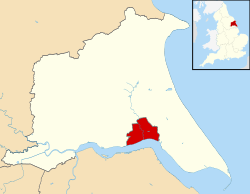
Shown within the East Riding of Yorkshire
|
||
| Sovereign state | United Kingdom | |
| Country | England | |
| Region | Yorkshire and the Humber | |
| Ceremonial county | East Riding of Yorkshire | |
| Founded | 12th century | |
| City status | 1897 | |
| Administrative headquarters | Guildhall | |
| Government | ||
| • Type | Unitary authority | |
| • Body | Hull City Council | |
| Area | ||
| • Land | 27.59 sq mi (71.5 km2) | |
| Population
(2005 est.)
|
||
| • City | 259,778 (Ranked 64th) | |
| • Rank | (Ranked 64th) | |
| • Density | 9,410/sq mi (3,633/km2) | |
| • Urban | 314,018 | |
| • Metro | 573,300 (LUZ) | |
| • Ethnicity (2011 Census) |
|
|
| Demonym(s) | Hullensian | |
| Time zone | UTC+0 (Greenwich Mean Time) | |
| • Summer (DST) | UTC+1 (British Summer Time) | |
| Postcode Area |
HU
|
|
| Dialling codes | 01482 | |
| ISO 3166-2 | GB-KHL | |
| ONS code | 00FA (ONS) E06000010 (GSS) |
|
| NUTS 3 | UKE11 | |
| Police | Humberside | |
| Ambulance | Yorkshire | |
| Fire | Humberside | |
Kingston upon Hull, often called Hull, is a port city in the East Riding of Yorkshire, England. It sits where the River Hull meets the Humber Estuary. This is about 25 miles (40 km) from the North Sea. Hull is also 37 miles (60 km) south-east of York.
With a population of around 267,000 people (as of 2021), Hull is the fourth-largest city in the Yorkshire and the Humber region. It is smaller than Leeds, Sheffield, and Bradford. Hull has a rich history of over 800 years connected to the sea. It is known as Yorkshire's maritime city.
The town was first called Wyke on Hull. Monks from Meaux Abbey founded it in the late 1100s. They used it as a port to export their wool. In 1299, King Edward I bought the town and renamed it Kings-town upon Hull. Over time, Hull became a busy market town, a military supply port, and a center for trade, fishing, and whaling.
Hull played an important part in the English Civil Wars. In the 1700s, William Wilberforce, a Member of Parliament from Hull, helped end the slave trade in Britain.
During the Second World War, Hull was heavily bombed. More than 95% of the city was damaged or destroyed. After the war, the damaged areas were rebuilt. In the early 2000s, Hull saw a lot of new buildings for shops, businesses, homes, and public services.
Today, Hull offers many museums, art galleries, and beautiful buildings. It also has a lively arts scene. The city has become a popular place for filming movies and TV shows. This is especially true for historical dramas that use the old streets of the Old Town. Because of this, Hull has earned the nickname "Hullywood." Shows like The Crown and movies like Enola Holmes 2 have been filmed here.
In 2017, Hull was named the UK City of Culture. It hosted the famous Turner Prize art exhibition at the city's Ferens Art Gallery. Other well-known places in Hull include the Minster, the tidal surge barrier, the Paragon Interchange, and The Deep aquarium. Hull University was founded in 1927 and has over 16,000 students. The city is also home to several rugby league and football teams.
Hull has been recognized as a great place to visit. In 2024, Time Out magazine ranked it second on its list of the 15 best places to visit in the UK. They praised The Deep, the Old Town, and the growing art galleries. In 2016, Rough Guides listed Hull as one of the top 10 cities in the world to visit.
Contents
- Exploring Hull's Past: A Journey Through Time
- How Hull is Governed
- Hull's Location and Environment
- Who Lives in Hull?
- Industries and Economy
- Shopping and Entertainment
- Culture and Arts in Hull
- Religion in Hull
- Parks and Green Spaces
- Media in Hull
- Sports in Hull
- Getting Around Hull
- Public Services and Infrastructure
- Education in Hull
- Hull's Unique Dialect and Accent
- Famous People from Hull
- Hull's International Connections
- Freedom of the City of Hull
- Images for kids
- See also
Exploring Hull's Past: A Journey Through Time
How Hull Began: Wyke and the Wool Trade
Kingston upon Hull is located on the north bank of the Humber Estuary. This is where the River Hull flows into it. People have lived in the River Hull valley since the early Neolithic period. However, there wasn't a large settlement where the city is now.
The area was good for people because it had access to rich land and rivers for boats. But the actual site was low-lying and didn't have fresh water. It was first a small part of a village called Myton, and was known as Wyke. The name Wyke might come from a Scandinavian word meaning "inlet" or a Saxon word meaning "dwelling place."
The River Hull was a safe place for ships. They traded wool from Meaux Abbey, which owned Myton. In 1293, King Edward I bought the town of Wyke from the abbey. On April 1, 1299, he gave it a royal charter. This charter officially renamed the settlement King's town upon Hull, or Kingston upon Hull. You can still see this original charter at the Guildhall.
In 1440, another charter gave the town more local power. It set up a local government with a mayor, a sheriff, and twelve aldermen.
Hull's Growth as a Busy Port
Hull's port was important for King Edward I during the First War of Scottish Independence. Later, it became the most important port on England's east coast. It grew rich by exporting wool and woollen cloth. It also imported wine and timber. Hull had strong trade links with Baltic ports that were part of the Hanseatic League.
From its early days, Hull mainly traded with Scotland and northern Europe. Countries like Scandinavia, the Baltic states, and the Netherlands were key trading partners. Hull also traded with France, Spain, and Portugal.
Sir William de la Pole was Hull's first mayor. He was a successful merchant whose family became important in government. Another successful person from a Hull trading family was Bishop John Alcock. He founded Jesus College, Cambridge and supported the grammar school in Hull.
The town did very well during the 1500s and early 1600s. Many well-kept buildings from this time still exist. One example is Wilberforce House, which is now a museum about William Wilberforce.
During the English Civil War, Hull became very important. It had a large arsenal (a place where weapons are stored). In 1642, King Charles I wanted to control Hull. But the town leaders and Sir John Hotham supported Parliament. They refused to let King Charles I enter the town. This led to the siege of Hull, which helped start the open fighting between Parliament and the Royalists.
After the Civil War, new docks were built. They followed the path of the old town walls, which were taken down. The first dock (Queen's Dock) was built in 1778. Two more docks, Humber Dock (1809) and Junction Dock (1829), were added later. Junction Dock was later renamed Prince's Dock.
Whaling was a big part of Hull's economy until the mid-1800s. As ships changed from sail to steam, Hull's trade reached all over the world. Docks were opened to handle frozen meat from Australia, New Zealand, and South America. Hull was also a hub for trade within the United Kingdom.
Becoming a City and Facing Challenges
In the late 1800s and early 1900s, Hull's port played a huge role in people moving to the New World. Thousands of people from Northern Europe sailed to Hull. They would stop there for paperwork before traveling to Liverpool and then to North America.
During this time, the Wilson Line of Hull shipping company grew. By the early 1900s, it was the largest privately owned shipping company in the world. It had over 100 ships sailing globally.
Hull was at its richest just before the First World War. In 1897, it was officially granted city status. Many of Hull's western suburbs were built in the 1930s. This was part of a large housing boom in Britain.
Hull During World War II and Beyond
Hull's port and factories, its closeness to Europe, and its location on a major estuary made it a target during the Second World War. Much of the city center was destroyed by bombs. Hull had 95% of its homes damaged or destroyed. This made it one of the most bombed cities in Britain, after London. Over 1,200 people died in air raids, and about 3,000 were injured.
The worst bombing happened in 1941. At the time, the rest of the country didn't know much about Hull's destruction. News reports called it "a North-East town" or "a northern coastal town." Most of the city center was rebuilt after the war.
After the war, the whaling industry declined. Then, deep-sea trawling (fishing) became important. But the Cod Wars of 1975–1976 led to Hull's economic decline.
Hull as UK City of Culture
In 2017, Hull was named the 'City of Culture' by the government. The city held many festivals and events in public spaces to celebrate. At the start of the year, a huge firework display attracted 25,000 people.
The city came 2nd in the Time Out list of the 15 best places to visit in the UK in 2024. The guide praised "The Deep, an enormous aquarium with 3,000 species, a picturesque old town which survived the city's relentless WWII bombings, and lots of up and coming indie art galleries".
How Hull is Governed
Local Government in Hull
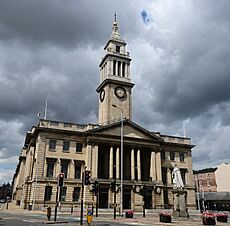
After the Local Government Act 1888, Hull became a county borough. This meant it was a local government area independent of the East Riding of Yorkshire. This changed in 1974 when it became part of the new county of Humberside. Humberside was later removed in 1996, and Hull became a unitary authority area. This means it manages its own local services.
The local council for Hull is called Hull City Council. Its main office is in the Guildhall in the city center. The council has worked hard to improve its services over the years.
The Liberal Democrats gained control of the City Council in the 2007 local elections. They kept control for several years. In 2011, the Labour Party took control. However, the Liberal Democrats won back control in the 2022 local elections.
Hull's Representatives in Parliament
The city sends three Members of Parliament (MPs) to the House of Commons. In the 2019 general election, these were Emma Hardy, Diana Johnson, and Karl Turner, all from the Labour Party.
William Wilberforce is the most famous former MP from Hull. He was born in the city and was an MP for Hull from 1780 to 1784. He played a key role in ending the slave trade.
Hull's Location and Environment
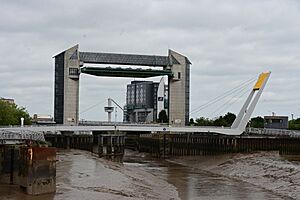
Kingston upon Hull is on the northern bank of the Humber Estuary. The city center is west of the River Hull and close to the Humber. The land in Hull is very flat, only about 2 to 4 meters (6.5 to 13 ft) above sea level.
Some parts of Hull are on land that was once underwater. The Hull Tidal Surge Barrier is where the River Hull meets the Humber Estuary. It is lowered when very high tides are expected. This barrier protects about 10,000 homes from flooding. Because it is so low, Hull faces a growing risk of flooding due to global warming.
Historically, Hull has been affected by floods from the Humber. Major floods happened in the 1950s. In June 2007, many areas of Hull flooded again. About 8,600 homes and 1,300 businesses were affected.
More flooding in 2013 led to a new flood defense plan. This plan protects homes and businesses along 4 miles (6.4 km) of the Humber bank. It was finished in early 2021.
Hull is about 30 miles (48 km) north of where an earthquake measuring 5.3 on the Richter scale happened in 2008. This was a strong earthquake for this area. Another earthquake happened in June 2018.
Hull's Weather and Climate
Hull has a mild maritime climate. This means the weather changes often. The Gulf Stream makes the region warmer than other places at the same latitude. Hull is also sunnier and drier than most places this far north in Britain. This is because the Pennines mountains block some rain.
The highest temperature ever recorded in Hull was 36.9°C (98.4°F) in July 2022. In an average year, the warmest day usually reaches about 28.8°C (83.8°F).
The lowest temperature ever recorded was -11.1°C (12.0°F) in January 1982. Winters are generally mild, with snow only a few times a year. It is often cloudy, and winds from the North Sea can make it feel colder.
In November 1981, two tornadoes hit Hull. The second one was stronger and caused damage to homes in the north-eastern parts of the city.
Who Lives in Hull?
In 2021, Hull had a population of 267,014 people. The city's population has changed over time.
In 2001, about 53,000 people were under 16 years old. Most of the population (97.7%) was white. The largest minority group was Chinese, with 749 people. About 3% of people in Hull were born outside the United Kingdom. By 2006, Iraqi Kurds were the largest minority group, estimated at 3,000. Many of them were placed in the city while seeking asylum.
Historically, people from many different countries and faiths have lived around Hull's docks and Old Town. They came from European ports like Hamburg, especially between 1850 and 1914. Over 2 million people passed through Hull on their way to new lives in America and other places. Some decided to stay. These communities, including Dutch, Jews, Germans, and Scandinavians, were sometimes very involved in the city's life.
Industries and Economy
Hull's Port and Shipping
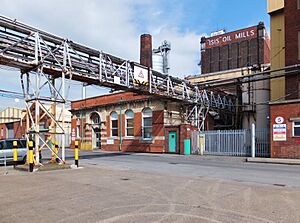
While the fishing industry declined in the 1970s, Hull remains a very busy port. It handles 13 million tonnes of cargo each year. Port operations employ 5,000 people directly. Another 18,000 jobs are linked to the port's activities. The port's railway line runs 22 trains every day.
Energy and New Developments
In 2011, Siemens Wind Power and Associated British Ports agreed to build a wind turbine blade factory at Alexander Dock. This plant would make large blades for offshore wind turbines. It was approved in 2014.
A large waste-to-energy center, called 'Energy Works', was also planned. This £150 million plant would process up to 200,000 tonnes of organic waste each year. It would produce energy using a special gasification process. It began operating in 2019.
Other Industries and Services
Hull Marina was built on land that used to be railway docks. It opened in 1983 and has 270 berths for yachts and small boats.
In 2014, the old Fruit Market area was cleared. A new technology hub, C4DI (Centre for Digital Innovation), was built there in 2015.
Hull also has chemical and healthcare industries. Smith & Nephew, a healthcare company, was founded by Thomas James Smith from Hull. The University of Hull and Hull York Medical School support research in healthcare.
After the decline of fishing, Roll-on Roll-off ferry services to Europe began. These ferries carry over a million passengers each year.
Shopping and Entertainment
Shopping in Hull
Hull has many shopping streets both in and outside the city center. Main shopping streets outside the center include Hessle Road, Holderness Road, and Beverley Road.
The city also has two covered shopping arcades, Paragon and Hepworth. Trinity Market Hall is an old indoor market from the Edwardian era. It has 50 stalls and was last updated in 2016.
Hull city center has three main shopping centers: St Stephen's, Princes Quay, and the Prospect Centre. The Prospect Centre is smaller and older but gets many visitors. It has chain stores, banks, and the city's main post office.
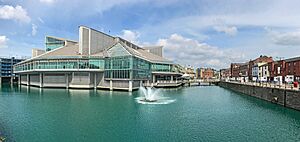
Princes Quay Shopping Centre was built in 1991 on stilts over the old Prince's Dock. It has shops and food places. The top floor was turned into a cinema in 2007.
St Stephen's shopping center opened in 2007. It is a large complex with a supermarket, many shops, food outlets, a hotel, and a 7-screen cinema. Since it opened, many shoppers have moved from other areas to St Stephen's.
Nightlife and Fun Places
The Old Town is a popular area for pubs and bars. One pub, The George Hotel, has Hull's smallest window.
Spiders is an alternative rock nightclub on Cleveland Street. It opened in 1979 in a building that used to be a pub.
The 'ATIK' nightclub is next to the Princes Quay shopping center and the historic Princes Dock.
Culture and Arts in Hull
Hull has several important museums. The city also has a strong history in theater, with famous actors and writers from Hull. The city's art and history help attract visitors and boost tourism. Hull has many different types of buildings, along with parks, squares, and sculptures. The author Val Wood sets many of her popular novels in Hull.
The Wilberforce Lecture and Medallion are given out each year. They celebrate Hull's role and William Wilberforce's efforts to fight human rights abuse.
In 2013, Hull bid to be the UK City of Culture in 2017. On November 20, 2013, it was announced that Hull had won the award.
A special Monopoly game was released for Hull. It features attractions like The Deep and St Stephen's.
Hull's Museums
The Museums Quarter is a group of four museums on High Street in the Old Town. It also has a leisure garden. The project cost £5.1 million and opened in 2003.
The museums are:
- Wilberforce House: The birthplace of William Wilberforce, who fought to end slavery.
- Arctic Corsair: A deep-sea trawler that became a museum ship in 1999.
- Hull and East Riding Museum: Shows the history and archaeology of the region.
- Streetlife Museum of Transport: Has a collection of old cars, public transport vehicles, and horse-drawn carriages.
Other museums include the Hull Maritime Museum, the Spurn Lightship, and The Deep, a large public aquarium.
Art and Galleries in Hull
The main art gallery is the Ferens Art Gallery on Queen Victoria Square. It is named after Thomas Ferens, who provided the money for it. Other galleries include the Humber Street Gallery, which opened in 2017 as part of the City of Culture events.
Public Art and Sculptures
Hull has many historical statues. These include the Wilberforce Memorial in Queen's Gardens and the golden King William III statue on Market Place, known as "King Billy." There is also a statue of Hull-born aviator Amy Johnson and a statue of poet Philip Larkin at Hull's Paragon Interchange.
In 2010, an art event called Larkin with Toads displayed 40 giant toad models. These were part of the Larkin 25 festival. Most of these sculptures were later sold for charity.
The Seven Seas Fish Trail celebrates Hull's fishing history. It guides people through the city with various sea creatures carved into the pavement. There is also an elephant trail along Spring Bank. This trail remembers the old Victorian Zoological Gardens.
In 2019, blue plaques appeared around Hull as part of the Alternative Heritage project. These plaques celebrate lesser-known and quirky facts about Hull.
The "Dead Bod" was a famous graffiti painting on the Alexandria Dock. It is now displayed in the Humber Street Gallery.
Three Ships Mural
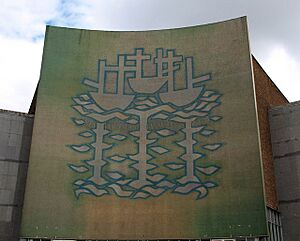
A large mosaic mural called "Three Ships" is on the old Co-operative store building in the city center. The building was set to be demolished, but it was listed as a Grade II historic building. This might help save the mural.
Theaters and Performance Venues
Hull has two main theaters. Hull New Theatre opened in 1939 and was recently refurbished. It is the largest venue and hosts musicals, opera, ballet, and children's shows.
The Hull Truck Theatre is a smaller, independent theater. It was started in 1971 and often shows plays by John Godber. Since 2009, Hull Truck Theatre has been in a new, modern building.
Many famous actors from stage and TV were born or grew up in Hull. These include Sir Tom Courtenay, Ian Carmichael, and Maureen Lipman.
In 2018, a new 3,000-seat arena opened in the city center. It hosts concerts and other events.
Festivals and Events
The Humber Mouth is an annual literature festival. The Hull Jazz Festival takes place every August near the Marina.
Since 2008, Hull has held its Freedom Festival. This is a free arts and live music event that celebrates freedom. Famous performers have appeared here. In 2017, former UN Secretary-General Kofi Annan received the Wilberforce Medallion at the festival.
In early October, Hull Fair comes to the city. It is one of Europe's largest travelling funfairs.
The city's Pride in Hull festival is one of the biggest free LGBT+ Pride events in the UK. It attracts over 50,000 people.
The Hull Global Food Festival is another annual event. In 2007, it attracted 125,000 visitors.
In 2010, Hull celebrated the 25th anniversary of the poet Philip Larkin's death with the Larkin 25 Festival. This included the popular Larkin with Toads art event.
Religion in Hull
Unlike many other English cities, Hull does not have a cathedral. However, since 2017, the Holy Trinity Church, which dates back to 1300, became a Minster. It is now known as Hull Minster. It is part of the Anglican Diocese of York.
Hull is also part of the Roman Catholic Diocese of Middlesbrough. St Charles Borromeo is the oldest Roman Catholic church in the city built after the Reformation.
There are also several missions and churches for sailors in Hull.
Parks and Green Spaces
Hull has many parks and green spaces. These include East Park, Pearson Park, Pickering Park, and West Park. West Park is home to Hull's MKM Stadium.
Pearson Park has a lake and a 'Victorian Conservatory' with birds and reptiles. East Park has a large boating lake and a collection of animals. Both East Park and Pearson Park are listed as Grade II historic sites.
The city center has the large Queen's Gardens park. This park was built on the site of the old Queen's Dock. It is now used for concerts and festivals. The gardens are currently undergoing a major redevelopment.
The streets in Hull's suburbs also have many trees. This is especially true in the Avenues area. Many old trees in the Avenues have been cut down. Their stumps have been carved into 'living sculptures'.
West Hull has an area called 'Botanic'. This name comes from a short-lived Botanic Garden that used to be there. Elephants once lived nearby in the former Zoological Gardens on Spring Bank.
Media in Hull
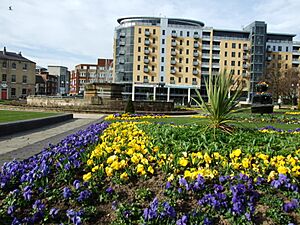
Hull's local daily newspaper is the Hull Daily Mail. In the past, Hull had three competing daily newspapers.
The BBC has its regional headquarters for Yorkshire and Lincolnshire in Hull.
Radio stations broadcasting from Hull include Hull Kingston Radio and 106.9 West Hull FM. BBC Radio Humberside is also based in Hull.
Sports in Hull
Hull is home to many sports, including professional football, rugby league, and rugby union.
The city's professional football club is Hull City A.F.C.. They play in the EFL Championship, which is the second tier of English football. Their home ground is the MKM Stadium.
Rugby league is very popular in Hull. The city has two teams in the Super League competition. These are Hull FC, founded in 1865, and Hull Kingston Rovers. Hull FC plays at the MKM Stadium, and Hull Kingston Rovers plays at Sewell Group Craven Park Stadium.
Rugby union teams include Hull Ionians and Hull RUFC. Both play in the National League 2 North.
Hull has two athletics clubs, Kingston upon Hull Athletics Club and Hull Achilles Athletics Club. They are based at the Costello Stadium.
Hull Arena is an ice rink and concert venue. It is home to the Hull Seahawks ice hockey team. It also hosts the Kingston Kestrels ice sledge hockey team.
The city hosted the Clipper Round the World Yacht Race in 2009–10. The yacht named Hull and Humber came in second place in the 2007–2008 race.
Swimming pools in Hull include Beverley Road Baths and Albert Avenue Baths. Albert Avenue pools were recently refurbished and reopened in 2023.
Getting Around Hull
Hull Paragon Interchange, which opened in 2007, is the city's main transport hub. It combines the main bus and train stations. About 24,000 people pass through it every day.
Train Services
Hull Paragon Interchange has train services from four companies:
- Hull Trains runs regular express services to London King's Cross.
- London North Eastern Railway has one service per day to London King's Cross.
- TransPennine Express runs trains to Manchester Piccadilly via Leeds.
- Northern Trains operates local trains to places like Halifax, York, Sheffield, and Scarborough.
Bus Services
Bus services in and around Hull are provided by East Yorkshire and Stagecoach in Hull. Bus users can get a Hull Card to use on services from both companies.
Bridges in Hull
Hull is close to the Humber Bridge. This bridge connects Hull to areas south of the Humber River. When it was built between 1972 and 1981, it was the longest single-span suspension bridge in the world.
In 2021, a new footbridge called Murdoch's Connection opened. It connects the city to the waterfront, marina, and fruit market over Castle Street. It is named after Hull's first female doctor, Mary Murdoch.
Ferry Services
P&O Ferries offers daily overnight ferry services from King George Dock in Hull to Rotterdam. The ferries MS Pride of Rotterdam and MS Pride of Hull use a special terminal built for them. In 2021, P&O Ferries stopped their overnight ferry service to Zeebrugge.
Airports Near Hull
The closest airport is Humberside Airport, about 20 miles (32 km) away in Lincolnshire. It offers some charter flights and regular flights to Amsterdam and Aberdeen.
The nearest airport with flights to other continents is Leeds Bradford Airport, about 70 miles (110 km) away.
Cycling in Hull
Cycling is very popular in Hull. According to the 2001 census, 12% of people cycled to work. This is much higher than the national average of 2%. In 2011, a report ranked Hull as the fourth-best cycling city in the UK.
Roads Around Hull
The main road into and out of Hull is the M62 motorway/A63 road. This is a major route in Northern England. It connects Hull to cities like Leeds, Manchester, and Liverpool. The motorway ends some distance from Hull, and the rest of the route is a dual carriageway.
Traffic in Hull can be slow because of the many bridges over the River Hull. These bridges open for boats, causing delays.
Public Services and Infrastructure
Telephone System
Hull is unique in the UK because it has its own independent telephone company, KCOM. You can spot their special cream-colored telephone boxes around the city. KCOM was started in 1902 by the City Council. It is the only locally run telephone company in the UK, though it is now privately owned.
KCOM was one of the first companies in Europe to offer fast internet (ADSL) to businesses. In October 2019, Hull became the first UK city to have full fiber broadband available for all residents.
Public Services in Hull
Humberside Police provides policing in Hull. In 2006, they were ranked as one of the worst-performing police forces in the UK. However, they improved significantly in the following years.
HM Prison Hull is a prison located in the city. It holds up to 1,000 adult male prisoners.
The Humberside Fire and Rescue Service provides fire and rescue services. They have their headquarters near Hessle and five fire stations in Hull.
Hull and East Yorkshire Hospitals NHS Trust provides healthcare from Hull Royal Infirmary and Castle Hill Hospital. The Yorkshire Ambulance Service provides emergency patient transport.
Waste management in Hull is handled by the local authority. The Waste Recycling Group works with Hull City Council to manage waste. They plan to build a plant at Salt End to turn waste into energy.
Yorkshire Water manages Hull's drinking and waste water. Drinking water comes from boreholes and the River Hull. Waste water is pumped to a treatment plant at Salt End.
Education in Hull
Higher Education Opportunities
University of Hull
Kingston upon Hull is home to the University of Hull. It was founded in 1927 and became a Royal Charter university in 1954. It has about 20,000 students. The main campus is in North Hull. Famous people who studied here include former Deputy Prime Minister John Prescott and Nobel Prize winner Guido Imbens.
University of Lincoln
The University of Lincoln started from a former polytechnic in Hull. In the 1990s, its main focus moved to Lincoln. However, the University of Lincoln still has a campus in Hull city center.
Specialist Education
Hull York Medical School is a joint project between the University of Hull and the University of York. It started in 2003 to train more doctors.
The Northern Academy of Performing Arts and Northern Theatre School teach musical theater, performance, and dance.
The Hull School of Art, founded in 1861, is known for its creative higher education programs.
Colleges in Hull
Hull has a further education college, Hull College. It also has two large sixth form colleges, Wyke College and Wilberforce College. East Riding College offers adult education in the city.
Schools in Hull
Hull has over 100 local schools. Hull City Council supports 14 secondary schools and 71 primary schools. Malet Lambert School is the highest-achieving state school in Hull.
Schools that are independent of the City Council include Hymers College and Tranby School. Hull Trinity House Academy has trained future sailors since 1787. It was a boys-only school until September 2022, when it started admitting girls. This made Newland School for Girls the only single-sex school left in the city.
Hull has faced challenges with exam results for many years. However, there have been improvements.
Hull's Unique Dialect and Accent
The way people speak in Hull is quite special. It's different from the rest of the East Riding, but it's still part of the Yorkshire accent. One noticeable thing is how some words are pronounced. For example, "goat" might sound like "gert" to some people.
Like many places in England, people in Hull sometimes drop the 'H' sound at the start of words. So, Hull might sound like 'Ull. However, the vowel sound in "Hull" is pronounced like in northern English.
Another feature of the Hull accent is how the vowel sound in words like burnt, nurse, and first is pronounced. It sounds similar to the 'e' in "bed." This is different from most of Yorkshire.
Famous People from Hull
People from Hull are called "Hullensians." Many famous people have been born or lived in the city.
Historically, William Wilberforce, who helped end slavery, is a key figure. Amy Johnson, the aviator who was the first woman to fly solo from England to Australia, was also from Hull.
Entertainers from Hull include actors Sir Tom Courtenay, Ian Carmichael, Maureen Lipman, and Reece Shearsmith. Playwrights Richard Bean, John Godber, and Alan Plater also have strong links to Hull.
Musicians from Hull include Paul Heaton of The Housemartins, and guitarists Mick Ronson and Trevor Bolder, who worked with David Bowie.
The astrophysicist Edward Arthur Milne and logician John Venn were both from Hull. The poet Philip Larkin lived in Hull for 30 years and wrote much of his work there.
Chemist George William Gray worked at the university for 45 years. He developed the first stable liquid crystals, which were used in electronic screens.
Notable sportspeople include Ebenezer Cobb Morley, who helped create modern football. Clive Sullivan, a rugby league player, was the first black Briton to captain a national team. The main road into the city from the Humber Bridge is named after him. Footballers Nick Barmby and Dean Windass also played for Hull City.
Karl Bushby, an author and ex-paratrooper, is walking from Punta Arenas to Hull.
John Prescott, a former MP and Deputy Prime Minister, chose his peerage title from Hull, becoming Baron Prescott of Kingston-upon-Hull.
Hull's International Connections
Hull has official twinning agreements with several cities around the world:
- Chișinău, Moldova
- Freetown, Sierra Leone
- Fengtai, Beijing, China
- Niigata, Japan
- Raleigh, North Carolina, United States
- Reykjavík, Iceland
- Rotterdam, Netherlands
- Szczecin, Poland
Some cities are even named after Hull:
- Hull, Massachusetts, United States
- Hull, Quebec, Canada
Freedom of the City of Hull
The "Freedom of the City" is a special honor given to people and military units. Here are some who have received it in Kingston upon Hull:
Individuals Honored
- Desmond Tutu: 1987
- Helen Suzman: 1987
- Nelson Mandela: 1987
- John Prescott: 1996
- Kevin McNamara: 1997
- Jean Bishop – "Bee Lady": 2017
- Sir Thomas Courtenay: 2018
- Yvonne Blenkinsop: 2018
- Carol Thomas: 2022
- Patrick Doyle: 2022
Military Units Honored
- The East Yorkshire Regiment: 1944
- The Prince of Wales's Own Regiment of Yorkshire: 1958
- The Yorkshire Regiment: 2006
- The Royal Dragoon Guards
- 440 (Humber) light Anti-Aircraft Regiment Royal Artillery (TA): 1960
- 440 (Humber) light Anti-Aircraft Regiment Royal Artillery (Territorials): 1967
- RAF Patrington: 1970
- 150(N) Transport Regiment Royal Corps of Transport (Volunteers): 1990
- RRH Staxton Wold: 1994
- 150 (Yorkshire) Transport Regiment Royal Logistic Corps (Volunteers): 1994
- HMS Iron Duke, RN: 1994
- 250th Field Ambulance (Volunteer Unit): 1999
- Hull Unit Sea Cadet Corps: 2014
- Humberside and South Yorkshire Army Cadet Force: 2024
- 152 (City of Hull) Squadron Air Training Corps: 2024
Images for kids
-
Panorama of Hull from further along the north bank of the Humber near Paull, with the Yorkshire Wolds rising behind the city
See also
 In Spanish: Kingston upon Hull para niños
In Spanish: Kingston upon Hull para niños












